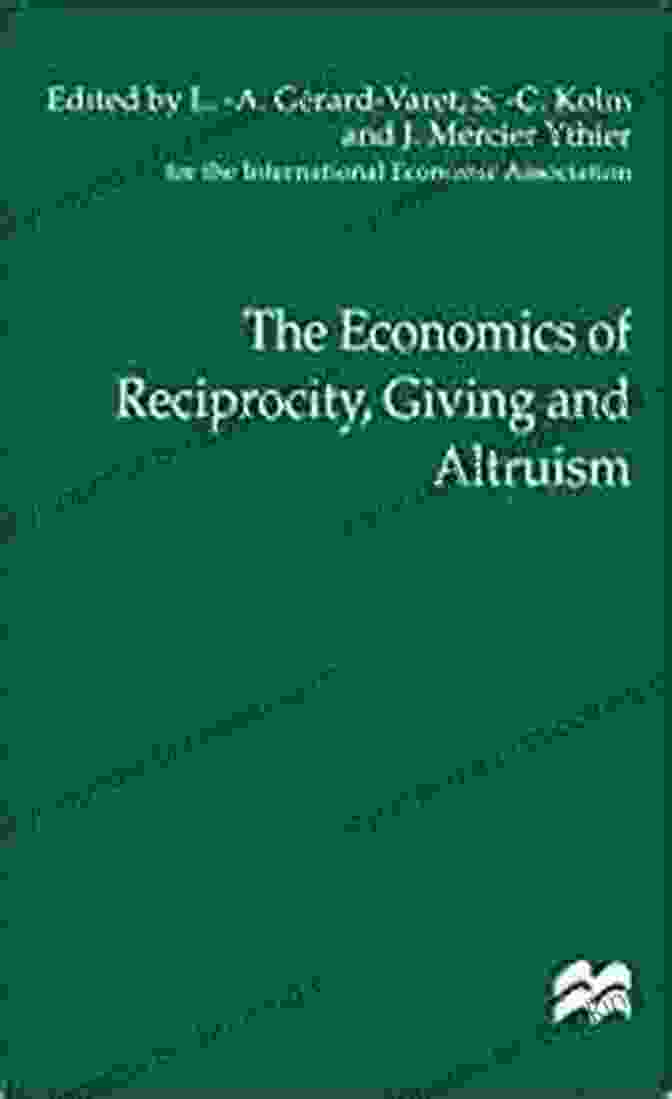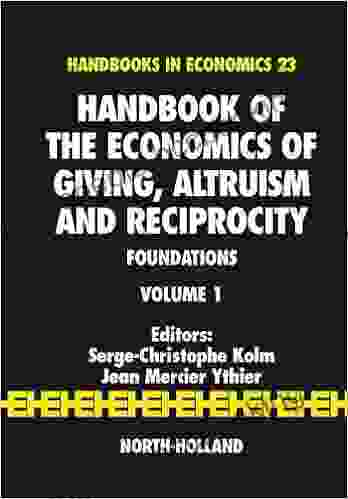The Handbook of the Economics of Giving, Altruism, and Reciprocity: Exploring the Motives and Consequences of Prosocial Behavior


Prosocial behavior, which encompasses altruism and reciprocity, plays a pivotal role in shaping human societies. The Handbook of the Economics of Giving, Altruism, and Reciprocity delves into the economic underpinnings of these behaviors, offering a comprehensive examination of their motivations, consequences, and implications. This groundbreaking volume brings together leading scholars from various disciplines to shed light on the complex interplay between economic incentives and prosociality.
Chapter 1: The Nature of Altruism
The opening chapter delves into the fundamental question of what motivates individuals to engage in altruistic acts. It examines the role of empathy, emotions, and social preferences in driving prosocial behavior. The chapter also explores the distinction between pure altruism and other forms of prosocial behavior, such as kin altruism and reciprocal altruism.
5 out of 5
| Language | : | English |
| File size | : | 16959 KB |
| Print length | : | 948 pages |
Chapter 2: Altruism and Public Policy
Chapter 2 investigates the implications of altruism for public policy. It examines how altruism can contribute to social welfare and how it can be harnessed to address social challenges. The chapter also discusses the potential pitfalls of relying on altruism and the role of government intervention in supporting prosocial behavior.
Chapter 3: Reciprocity and Social Exchange
Reciprocity is a fundamental aspect of human interaction, involving the exchange of goods, services, and favors. Chapter 3 explores the economic foundations of reciprocity, focusing on the role of reputation, social norms, and enforcement mechanisms. It also examines the implications of reciprocity for cooperation, competition, and social Free Download.
Chapter 4: Reciprocity in the Market
The relationship between reciprocity and market behavior is explored in Chapter 4. It investigates how reciprocity can influence consumer behavior, firm strategies, and the functioning of markets. The chapter also examines the potential for reciprocity to mitigate market failures and promote socially desirable outcomes.
Chapter 5: Altruism and Reciprocity in the Workplace
Chapter 5 examines the role of altruism and reciprocity in the workplace. It explores how prosocial behavior can improve employee motivation, collaboration, and organizational performance. The chapter also discusses the potential challenges and ethical dilemmas associated with promoting prosociality in the workplace.
Chapter 6: Altruism and Reciprocity in the Family and Household
Family and household relationships are a rich context for the expression of altruism and reciprocity. Chapter 6 examines the economic foundations of these relationships, focusing on the role of love, obligation, and social expectations. It also explores the implications of altruism and reciprocity for family decision-making, childrearing, and eldercare.
Chapter 7: Altruism and Reciprocity in the Non-Profit Sector
The non-profit sector plays a vital role in providing social services and addressing social challenges. Chapter 7 examines the economic foundations of the non-profit sector, focusing on the role of altruism, reciprocity, and social responsibility. It also explores the challenges facing the non-profit sector and the potential for economic analysis to inform policy and practice.
Chapter 8: Altruism and Reciprocity in Social Networks
Social networks are an important avenue for the expression of altruism and reciprocity. Chapter 8 investigates the economic foundations of social networks, focusing on the role of social capital, network structure, and reputation. It also examines the implications of altruism and reciprocity for social cohesion, information sharing, and collective action.
Chapter 9: The Neuroscience of Altruism and Reciprocity
Recent advances in neuroscience have shed new light on the neural underpinnings of altruism and reciprocity. Chapter 9 explores the role of brain regions such as the prefrontal cortex, amygdala, and insula in prosocial behavior. It also examines the implications of neuroscience research for understanding the motivations and consequences of altruism and reciprocity.
Chapter 10: Altruism and Reciprocity in the Global Context
Altruism and reciprocity are not confined to specific cultures or regions. Chapter 10 examines the cross-cultural variations in prosocial behavior, focusing on the role of cultural norms, social institutions, and economic conditions. It also explores the implications of altruism and reciprocity for global cooperation, development, and peacebuilding.
The Handbook of the Economics of Giving, Altruism, and Reciprocity is a comprehensive and authoritative exploration of the economic foundations of prosocial behavior. It provides a rigorous analysis of the motivations, consequences, and implications of altruism and reciprocity, offering valuable insights for researchers, policymakers, and anyone interested in understanding the social and economic dimensions of human behavior. By illuminating the economic forces that shape prosociality, this handbook contributes to the advancement of knowledge in the fields of economics, psychology, sociology, and anthropology, and lays the groundwork for future research and policy interventions to promote a more just and cooperative society.
5 out of 5
| Language | : | English |
| File size | : | 16959 KB |
| Print length | : | 948 pages |
Do you want to contribute by writing guest posts on this blog?
Please contact us and send us a resume of previous articles that you have written.
 Book
Book Novel
Novel Page
Page Chapter
Chapter Text
Text Story
Story Genre
Genre Reader
Reader Library
Library Paperback
Paperback E-book
E-book Magazine
Magazine Newspaper
Newspaper Paragraph
Paragraph Sentence
Sentence Bookmark
Bookmark Shelf
Shelf Glossary
Glossary Bibliography
Bibliography Foreword
Foreword Preface
Preface Synopsis
Synopsis Annotation
Annotation Footnote
Footnote Manuscript
Manuscript Scroll
Scroll Codex
Codex Tome
Tome Bestseller
Bestseller Classics
Classics Library card
Library card Narrative
Narrative Biography
Biography Autobiography
Autobiography Memoir
Memoir Reference
Reference Encyclopedia
Encyclopedia Alan Axelrod
Alan Axelrod Abigail Agar
Abigail Agar Abby Lee Miller
Abby Lee Miller Adam Stevenson
Adam Stevenson Alan Fleet
Alan Fleet Afro
Afro Adam Silvera
Adam Silvera Al K Line
Al K Line Al Ries
Al Ries Albert F Simon
Albert F Simon Abigail Tucker
Abigail Tucker A H Almaas
A H Almaas Adam Bray
Adam Bray Al Yellon
Al Yellon A R Vasishtha
A R Vasishtha Akiko Busch
Akiko Busch Alan J Hesse
Alan J Hesse Alan Madison
Alan Madison Abu Mussab Wajdi Akkari
Abu Mussab Wajdi Akkari Ai Publishing
Ai Publishing
Light bulbAdvertise smarter! Our strategic ad space ensures maximum exposure. Reserve your spot today!

 Dan BrownIncredible Animal Facts Reptile Edition: Unveiling the Wonders of the Reptile...
Dan BrownIncredible Animal Facts Reptile Edition: Unveiling the Wonders of the Reptile...
 Branden SimmonsUnlock the Power of Nursing: Your Ultimate Orientation and Care Guide in a...
Branden SimmonsUnlock the Power of Nursing: Your Ultimate Orientation and Care Guide in a... Miguel NelsonFollow ·5k
Miguel NelsonFollow ·5k Jamie BellFollow ·15.7k
Jamie BellFollow ·15.7k Elias MitchellFollow ·15.8k
Elias MitchellFollow ·15.8k Tyrone PowellFollow ·3k
Tyrone PowellFollow ·3k Brett SimmonsFollow ·10.3k
Brett SimmonsFollow ·10.3k Richard SimmonsFollow ·18.5k
Richard SimmonsFollow ·18.5k Jordan BlairFollow ·14.9k
Jordan BlairFollow ·14.9k Rudyard KiplingFollow ·3.4k
Rudyard KiplingFollow ·3.4k

 Francis Turner
Francis TurnerArt and Politics in the Shadow of Music
Music has...

 Jaylen Mitchell
Jaylen MitchellHow Algorithms Are Rewriting The Rules Of Work
The workplace is...

 Chandler Ward
Chandler WardRio de Janeiro & Minas Gerais Footprint Handbooks:...
Embark on an extraordinary adventure through...

 David Mitchell
David MitchellThe Story of Depression: Understanding and Treating a...
Delving into the Shadows of...

 Al Foster
Al FosterStatistics Done Wrong: The Woefully Complete Guide
Tired of being...

 DeShawn Powell
DeShawn PowellJulia Child's Second Act: A Tale of Triumph,...
Julia Child is an...
5 out of 5
| Language | : | English |
| File size | : | 16959 KB |
| Print length | : | 948 pages |








